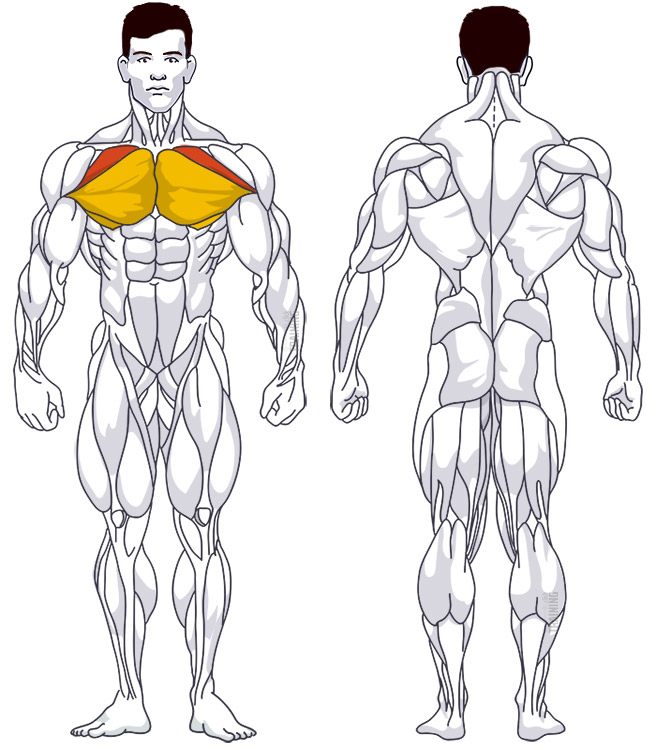Incline Dumbbell Press
Compound exercise, Free weightsThis article is verified by 2 studies/publications.
Overview

Main muscles
- Chest: Large pectoral muscle
(Musculus pectoralis major) - Chest: Small pectoral muscle
(Musculus pectoralis minor)
Training plans
Here you can find example plans for incline dumbbell press training:
Incline Dumbbell Press: Basics and alternatives

Involved main muscle groups:
Incline Dumbbell Press
The incline dumbbell press is a great exercise for targeting your upper chest muscles. It’s an alternative to the incline bench press with a barbell, involving essentially the same movement. You lie on an inclined bench and push two dumbbells vertically upward with your arms, engaging your chest, triceps, and shoulders.
The entire chest muscle is activated during this exercise, but the incline of the bench helps you focus more on the upper part of the chest.
You can also include dumbbell flat bench press and decline dumbbell bench press in your workout plan as other barbell alternatives for the bench press. To activate the upper pecs, you can alternatively perform flys on an incline bench(also on the cable pulley) and the incline chest press.
Correct execution
There’s no fixed rule for the angle adjustment of the bench when doing the incline bench press with dumbbells. Angles between 30 and 45 degrees are typically recommended.
A 2015 study showed that both settings have their benefits. Depending on the movement phase, both angles can offer an advantage. However, the 30-degree position proved to be more beneficial in this study due to greater activation of the lower portion of the pectoralis major muscle (large chest muscle)[1].
In contrast, another study from 2010 showed a higher activation of the upper part at an angle of 44 degrees (compared to 28 degrees)[2]. This study measured between 28, 44, and 56 degrees of inclination but found no significant differences in shoulder activation. This is somewhat unusual since a steeper setting shifts the movement toward the shoulder press.
That means you probably can’t go wrong with settings between 30 and 45 degrees, especially since the differences in the 2015 study are relatively small.
Video tutorial
Step-by-step instructions
Set the bench backrest to a positive angle between 30 and 45 degrees. Pick up the dumbbells, sit at the end of the bench, and place the dumbbells on your knees.
Lie down on the bench. At the same time, give the dumbbells a slight push up with your knees so that you can move them over your chest without much effort while lying down.
Now push the dumbbells up vertically over your chest, side by side, with your arms extended. The backs of your hands both point backward (toward your head).
Pull your shoulder blades back and form a slight hollow back.
Slowly lower the dumbbells by bending your elbows and pulling shoulders back. The elbows should not be spread too far outwards but should be directed as far as possible inwards, toward your body. Keep your shoulder blades contracted the entire time.
When you feel a stretch in your chest, you have reached the end of the downward movement. Hold this position for a short moment.
Push the dumbbells back up to the starting position through your chest by straightening your shoulders and elbows and moving your arms in front of your chest. Press the dumbbells vertically upward again.
Common mistakes
The “bridge” (hollow back) is also fine for the incline bench press, but to a lesser degree than in the flat bench press. Under no circumstances should you lift your butt off the bench. First and foremost, the bridge is meant to make contracting your shoulders as effective as possible.
This brings us to the next point: make sure your shoulders are pulled back throughout the entire execution. If they are not, this not only worsens your form but also increases the stress on the shoulder joints.
Sources
- Influence of bench angle on upper extremity muscular activation during bench press exercise. Lauver, J. D., Cayot, T. E., & Scheuermann, B. W. (2015). European Journal of Sport Science, 16(3), 309-316. doi:10.1080/17461391.2015.1022605. URL: https://www.tandfonline.com/doi/full/10.1080/17461391.2015.1022605, accessed on 24.08.2020
- An Electromyography Analysis of 3 Muscles Surrounding the Shoulder Joint During the Performance of a Chest Press Exercise at Several Angles. Trebs, A. A., Brandenburg, J. P., & Pitney, W. A. (2010). Journal of Strength and Conditioning Research, 24(7), 1925-1930. doi:10.1519/jsc.0b013e3181ddfae7